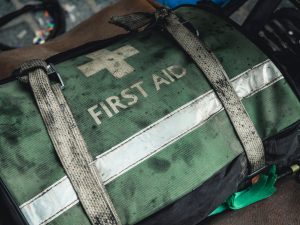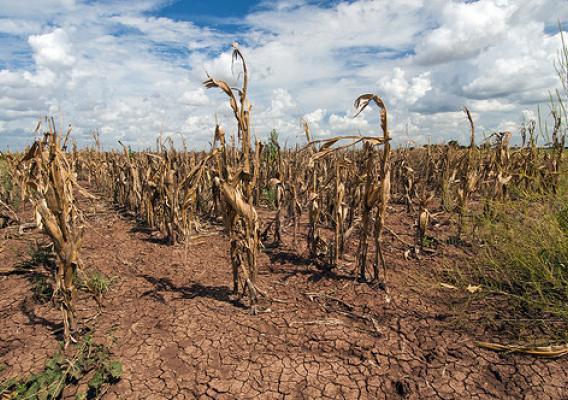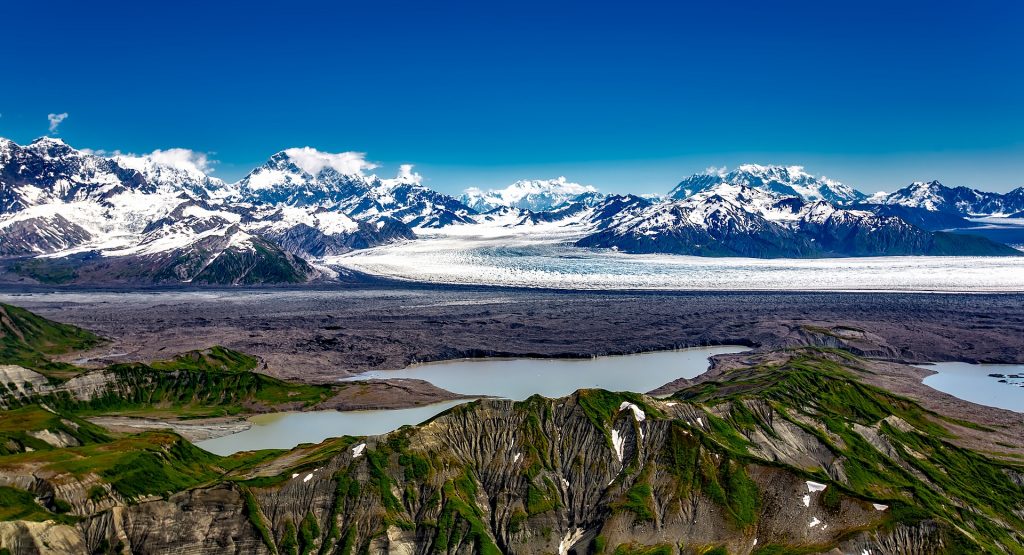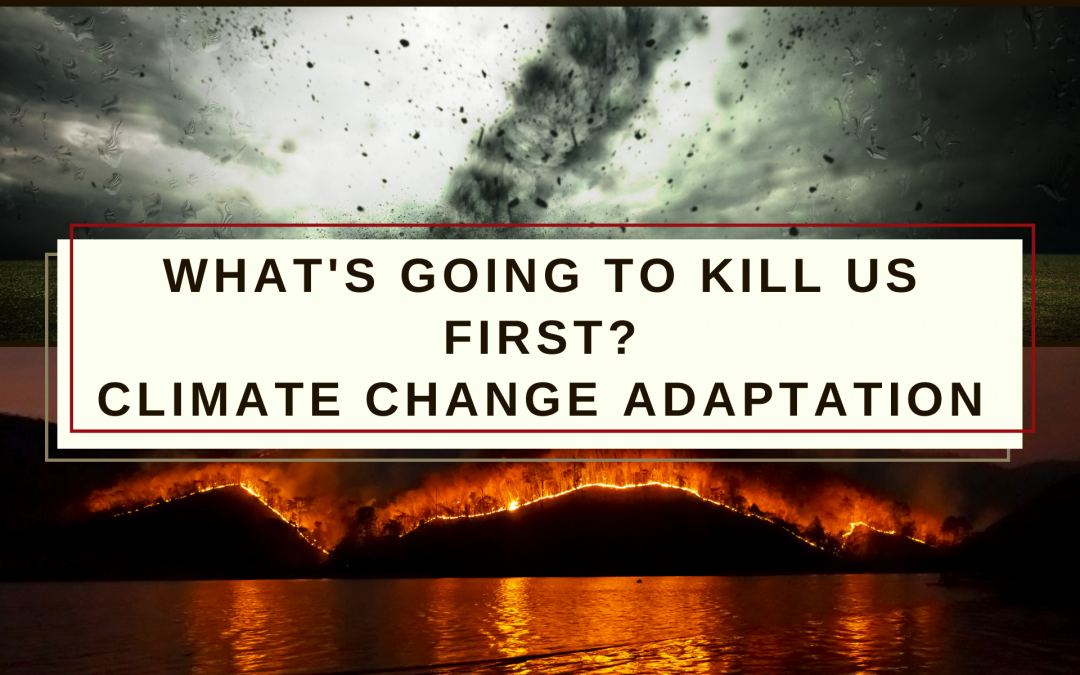What can we learn from trauma medicine when it comes to climate change?
There is a credo in emergency trauma medicine that says, “Treat First What Kills First“. There are clearly defined patterns and formulas to identify what kills first and should be treated first, like the (C)ABCDE (critical bleeding, airway, breathing, circulation, disability, environment) or MARCH algorithm.
Basically, what it says is, don’t start with CPR on a patient who has a severed femoral artery and will bleed to death within 60 seconds. Apply a tourniquet first to stop the bleeding, then start with CPR. Both, lack of oxygen and critical bleeding will kill the patient eventually, but the severed femoral artery will kill him first, so it has to be treated first.
Lately, I’ve been thinking a lot about “Treat First What Kills First” when it comes to climate change preparedness.
There are many things that will eventually threaten our lives. Wildfires and the resulting smoke, crop failures caused by droughts or flooding, and the resulting food shortages, lack of drinking-quality water, or heatstroke during extreme heatwaves and wet-bulb temperatures… You name it, the possibilities are almost endless.
So, why should we not apply the “Treat First What Kills First” approach?
The answer is, we absolutely should! The real question is HOW.

Treat First What Kills First in Climate Change Adaptation
In order to use this approach for climate change adaptation and preparedness, we have to begin by assessing risks. Risk assessment is something we do intuitively dozens of times every day. When doing so, we evaluate both the probability and severity of a damaging event to assess the actual risk. We then decide – in most cases intuitively – whether or not to take that risk.
For example, every time we get into a car to drive to work, we are in danger of getting into a fatal car accident, yet we decide the benefit from going to work is greater than the risk.
We have to take a similar approach to assess climate change risks, but instead of intuition, we have to base our assessment on scientific data. By taking a look at statistics and climate models we can create a ranking of climate-related hazards. This ranking should be our list of priorities when we start to prepare and adapt.
Unfortunately, it’s impossible to make a single risk ranking for the entire world. We have to take an individual look at different locations. The best possible generalization we can make is to assess the different climate zones.
Predictions for Earth’s different Climate Zones

Earth is generally separated into 4 different major climate zones. The tropical zone, Subtropics, Temperate zone, and Cold zone. Each will face its own challenges in the coming climate crisis. Here is my ranking for what I believe to be the “Kills First” for each zone.
Tropical Zone
- Lethal Wet-Bulb-Temperatures
The combination of high relative humidity and hot temperatures is already proving problematic in the tropical zone. It is safe to say, that any form of outdoor activity or labor will become impossible on more and more days of the year in this zone. When the human body is unable to dissipate heat through sweating, simply being outdoors can become lethal. A huge issue for the high-population-density countries near the equator.
Check out our article on Wet-Bulb Temperature to learn more about this topic. - Extreme Storms and Flooding
Due to the high solar radiation, a lot of water evaporates in the tropical zone and the air carries a lot of moisture. This leads to heavy storms and precipitation events like hurricanes or monsoons and can also affect the subtropics. - Crop Failures and Food Shortages due to Extreme Weather
As a direct consequence of the risks listed above, food shortages can lead to civil collapse and chaos within a short period of time. In 2020, we have seen huge crop losses in China due to unprecedented flooding around the Yangtze River and its tributaries. 13 million acres were lost within a short period of time.
Lethal wet-bulb-temperatures could lead to farmers unable to work in the fields.
This one reason why keeping good food storage is so important!
Subtropics
- Crop Failures and Food Shortages due to Droughts
While any sort of extreme weather event can occur in the subtropics, the biggest threat is extended droughts. Several parts of the US, South America, and Europe are currently experiencing severe drought. While the adverse effects can still be partially mitigated, we will be in serious trouble when harvests keep declining in the world’s food baskets. Again, prepare to bridge food shortages by storing your own food! - Extreme Heatwaves
During the summer, the subtropics receive almost as much radiation as the tropics but can reach much higher temperatures. Less moisture and cloud cover can lead to brutal heatwaves. Heatstroke and dehydration can occur just like in tropical wet-bulb temperatures. Mitigation is possible by seeking shade and staying hydrated but physical labor outdoors will still be almost impossible. - Wildfires
Just like crop failures, wildfires will drastically increase due to fewer and less consistent precipitation. We have just recently seen to devastating fire seasons in Australia and the west coast of the US. Most people fail to realize that those were not “historic events” but the new normal or – even worse – as good as it’s gonna get in the near future. If you live in an area that is already heavily affected by wildfires, consider strategic relocation to a safer area!

Temperate Zone
- Supply Chain Disruptions
Arguably, countries in the temperate zone will feel the most devastating direct effects of climate change much later than hotter countries. Unfortunately, this doesn’t mean they’ll be spared from Climate Chaos. The highly developed and industrialized countries of the temperate zone highly depend on global supply chains to keep their economy and civilization going. Many of those supplying nations are situated in the tropical or subtropical zone. Soybeans from those areas feed livestock and essential electronics and machinery are built there.
Disruption of enough of those supply chains would prove fatal for the highly dependent countries of the temperate zone. - Climate Refugees
In those areas that will be affected by climate change first, people will experience a lot of hardship and suffering. The logical consequence is that they will try to leave their homeland and reach countries in the temperate zone.
Already, the US and Europe are experiencing pressure from Latin America and Africa, where droughts and desertification destroy the livelihood of millions of people. Taking in climate refugees or forcefully blocking their borders to protect the dwindling resources is a moral dilemma. This is especially true because countries in the temperate zone will already be feeling a steep decline in wealth and security due to the crumbling global economy. It is safe to say that either way, social unrest or even war will be the consequence. - All kinds of Extreme Weather
Being in the temperate zone means that countries will have to prepare to all different kinds of extreme weather. Changing ocean currents and erratic jet streams can lead to extreme heatwaves but also to severe cold and precipitation as both, rain and snow. While overall climatic conditions will still allow for growing crops outdoors, the risk of crop failures will drastically increase. Adapting to many different extreme weather events will be costly and further strain the declining wealth of those nations.
Cold Zone
The cold zone faces problems similar to the temperate zone.
There is one additional issue though: Not enough food!
Today’s cold climate zone might actually benefit from warmer temperatures. Unfortunately, long winters with short days and little arable land still make for a very short and difficult growing season.

So, what can we do about it?
These prospects look pretty dire, right? The future doesn’t have to be so grim, though. We have still time to prepare and begin with adaptation!
Areas in the cold zone like Northern Canada or Siberia have a very low population density and could potentially house a lot of climate refugees. The effects of crop failures can be mitigated by transferring food production to climate-controlled environments indoors – a necessity for all countries! Hydroponic and Aquaponic Gardening are highly efficient methods of growing food and don’t depend on arable land or favorable climate zones.
At the end of the day, all of us can be a part of the solution.
Live as sustainably as possible!
Learn to produce your own food!
Store a lot of food to be prepared for food shortages and not be a burden!
Learn the skills you will need to adapt to a new world!

